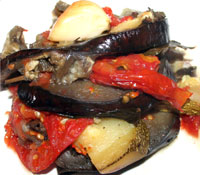|
| ||
| The ratatouille and I
by Ari LeVaux Ratatouille, a French dish of stewed vegetables, is a staple in my pantry and an important wintertime comfort food. More than anything else that I squirrel away in quantity for year-round consumption, Ratatouille is the epitome of summer in a jar. Dried fruit is wonderful too, but relatively one-dimensional. It offers only sweetness, while ratatouille is a fragrant whirlwind of flavors, a rich tapestry of chlorophyll and earth. Condiments like salsa, sauces and pickles are indispensable to a well-rounded stash, but they remain in support of the main event, while ratatouille can be a meal’s central pillar. And with tomato, eggplant, summer squash, garlic, peppers and herbs, ratatouille delivers practically an entire garden in every bite. French food is rustic at heart, forged by long-term relationships between a people and their landscape. Ratatouille illustrates the earthy roots of French cooking as well as any meal. A movie by the same name does justice to ratatouille while illustrating something entirely different: me. Yep, it’s a little known fact, but I’m actually an unseen star of “Ratatouille,” the 2007 animated film from Pixar. My persona, as it relates to food, is dissected by the movie into its component parts, each played by a different character: the rat, the klutz and the critic. Like me, Remy the rat is endowed with a large nose for flavor detection and an intuitive culinary compass. We share a fascination with the way distinct ingredients interact when chewed together, and the ways in which previously undetected flavors can be drawn out by food pairings. “Each flavor is totally unique,” Remy remarked at one point, “but combine one flavor with another and something new is created.” Then there’s Linguini, the skinny janitor who has no business in the kitchen other than cleaning it, and left to his own devices is more proficient at creating a mess than anything worth eating. This is me when anybody is watching, especially anybody who knows what they’re doing. I have no formal training, I rarely have a game plan, and I’m ignorant of much basic culinary terminology and technique. Like Linguini, I live in constant fear of being discovered as a fraud, and without my inner Remy I’d be useless.The third frame in this inkblot trilogy is the character of Anton Ego, the haughty food critic who wields his power with imperial ruthlessness. I too am a restaurant critic, and despite my own shortcomings I rarely pity the fool who serves me soggy chicharonnes or a weak margarita. But like Mr. Ego, I have my soft spots. “But that’s a peasant dish!” gasped Collette, the feisty and beautiful assistant chef, when Linguini announced he would serve ratatouille to the critic. But the rainbow-colored dish, concocted via the symbiotic relationship between Remy and Linguini, revealed Ego’s underbelly. At the taste of that ratatouille, Ego was transported back to his childhood, when his grandmother served her version of that peasant dish in her house in the country. The pen fell from Ego’s hands and bounced on the floor, and in that moment the rat and the klutz, watching from the kitchen, became one with the critic. All were fixated on Ego’s experience of the ratatouille. In that momentary fusion of three souls, and in the dynamic tension between them, I caught a glimpse of myself. But this doesn’t explain my soft spot for ratatouille, which has more to do with my sweetheart Shorty. Unlike Collette, Shorty doesn’t exactly own the kitchen with finely tuned chops and a sexy French accent. While Shorty’s talents are many, cooking, alas, isn’t one of them. Except when she makes ratatouille, at which point the kitchen muses gather upon her shoulders and garden spirits kneel like puppies at her feet. The house takes on the smell of a French country kitchen, and I begin to taste a year’s worth of meals as the counter fills with pint jars. Shorty is a peasant at heart, and ratatouille reveals her earthy brilliance. When I try to make it my way, Shorty becomes the critic, and I don’t question her authority. That’s why it’s her recipe, not mine, that follows. The basic proportions are one part summer squash, two parts eggplant and three parts tomato. Cut everything lengthwise or crosswise depending on your preference, into half-inch slices. Layer the veggies alternately, lasagna-like, interspersing whole garlic cloves and dried red chiles if you wish. Layer in basil leaves, rosemary, oregano and bay leaves. Pour safflower or olive oil liberally between the layers (about a quarter cup per eggplant), and sprinkle salt and pepper between the layers as well, along with a splash of cider vinegar. Bake covered at 350 for roughly an hour per inch of depth. The best timer is the dish’s water content, which is dependent on the tomatoes. You want to cook it until there’s no water left. Check by pulling the ratatouille away from the sides of the dish; keep cooking until the bottom is dry. The finished product can be canned in sterile glass jars - I like pints - in a pressure canner for 90 minutes at 11 pounds of pressure, or frozen in whatever freezerware you choose. When it comes time for a summertime flashback, serve your ratatouille on toast or pasta, or do like Shorty and inhale it straight out of the jar. Just as I’m a hybrid of klutzy kid, ruthless critic and gifted varmint, ratatouille is a mix of diverse elements that’s greater than the sum of its parts. As such, the dish is a bridge between city and country, connecting the roots and blossoms of a legendary cuisine. And if you make enough when the ingredients are plentiful – in other words, now – ratatouille will be your lifeline from the depths of winter to the heart of summer. And it will probably pry open the hearts of everyone who tries it. •
|


